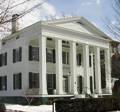
Greek Revival (1825 – 1860s)
With details reminiscent of the Parthenon, stately, pillared Greek Revival homes reflect a passion for antiquity.
History:
In the mid-19th century, many prosperous Americans believed that ancient Greece represented the spirit of democracy. Interest in British styles had waned during the bitter War of 1812. Also, many Americans sympathized with Greece’s own struggles for independence in the 1820s.
Greek Revival architecture began with public buildings in Philadelphia. Many European-trained architects designed in the popular Grecian style, and the fashion spread via carpenter’s guides and pattern books. Colonnaded Greek Revival mansions – sometimes called Southern Colonial houses – sprang up throughout the American south. With its classic clapboard exterior and bold, simple lines, Greek Revival architecture became the most predominant housing style in the United States.
During the second half of the 19th century, Gothic Revival and Italianate styles captured the American imagination. Grecian ideas faded from popularity. However, front-gable design – a trademark of the Greek Revival style – continued to influence the shape of American houses well into the 20th century. You will notice the classic front-gable design in simple “National Style” farm houses throughout the United States.
Features:
Pedimented gable
Symmetrical shape
Heavy cornice
Wide, plain frieze
Bold, simple moldings
Many Greek Revival houses also have these features:
Entry porch with columns
Decorative pilasters
Narrow windows around front door
Next: Gothic Revival Style